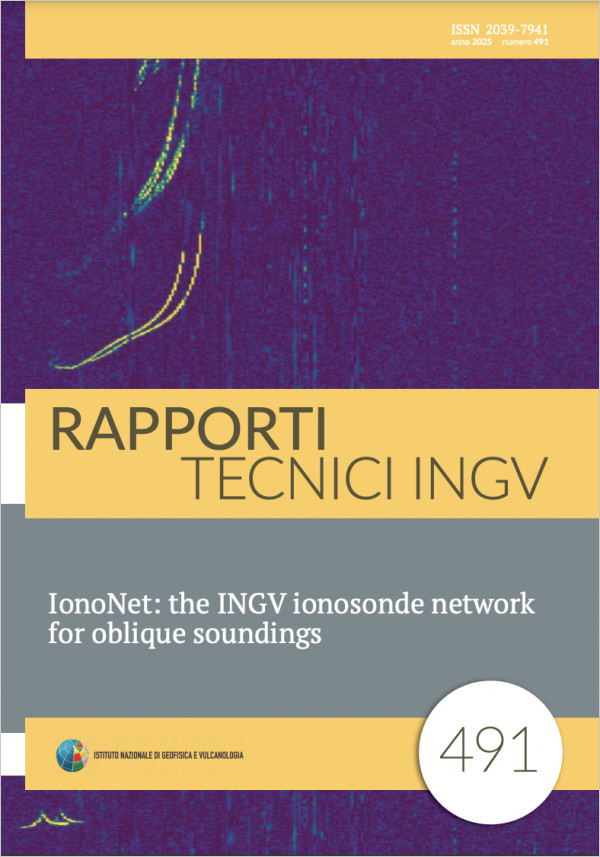IonoNet: the INGV ionosonde network for oblique soundings
Contenuto principale dell'articolo
Abstract
IonoNet is an INGV multistatic cooperative radar network of Pseudo Random Code (PRC) ionosondes for oblique ionosphere soundings placed in different points of the national territory; in this way it will be possible to compare the ionosphere characteristics relating to points separated by approximately a few hundreds of km. The project has been funded within the “Piano Nazionale di Ripresa e Resilienza” PNRR of INGV “Meet” inside the activity 9.5 “Design, realization and testing of ionosondes for oblique and vertical sounding, complete with data communication and remote access systems. Realization of the necessary software for the acquisition, pre-elaboration and automatic scaling of ionograms. Database of oblique and vertical ionograms, real-time electron density profiles and radio propagation parameters. Alert for disturbed ionospheric conditions.” The project activities concern the design and construction of ionosondes for oblique and vertical soundings. The instruments will be comprehensive of systems for communication and analysis of the acquired data with the transformation of the oblique ionograms into vertical ones, for a better comparison with the observatories ionograms. The “autoscala” software will be used for the realtime generation of the electron density profiles and the calculation of all propagation parameters; based on the output of “autoscala”, ionospheric alerts will be generated, for civil and military uses, in case of disturbed conditions.
The oblique PRC ionosondes are constituted by two parts, a transmitting and a receiving ionosonde located in different places. The PRC ionosondes have been built using Software Defined Radio (SDR) devices that act as transmitter or receiver of the Radio Frequency (RF) signals. They generate all the signals necessary for the operation of the ionosondes such as the GPS signals acquisition used for time synchronization, the triggering of the RF power amplifier for long distance sounding, and the antennas switches. The SDR device is able to convert into an RF signal a pseudo random numerical sequence generated by a Personal Computer (PC) or receive and convert the RF antenna signals into a pseudo random numerical sequence on the PC; this is accomplished by means of a high speed Ethernet port (1Gb per seconds), used also to transmit the SDR data and configuration parameters. There is a wide choice of SDR configurations and a great versatility for these devices; with the possibility of changing frequencies and amplitude of transmitted waveform or applying filters in different bands. The receiving PRC ionosonde, placed at one of the ionospheric observatory, allows receiving and detecting at the same time the pseudo random coded signal transmitted contemporarily from different ionosondes, multiplying the observation possibilities of the ionosphere from different directions. It is possible to use the code with different random seed (used as station identifier parameter) at the transmitting ionosondes and using a precise time synchronization between transmitting and receiving ionosondes; the high precision is obtained using a GPS Disciplined Oscillator (GPSDO). The surveys will allow to map the ionosphere over large regions for the verification of theoretical models of the global ionosphere and local disturbed ionospheric conditions, and to investigate possible ionosphere lithosphere coupling phenomena.
The oblique PRC ionosondes are constituted by two parts, a transmitting and a receiving ionosonde located in different places. The PRC ionosondes have been built using Software Defined Radio (SDR) devices that act as transmitter or receiver of the Radio Frequency (RF) signals. They generate all the signals necessary for the operation of the ionosondes such as the GPS signals acquisition used for time synchronization, the triggering of the RF power amplifier for long distance sounding, and the antennas switches. The SDR device is able to convert into an RF signal a pseudo random numerical sequence generated by a Personal Computer (PC) or receive and convert the RF antenna signals into a pseudo random numerical sequence on the PC; this is accomplished by means of a high speed Ethernet port (1Gb per seconds), used also to transmit the SDR data and configuration parameters. There is a wide choice of SDR configurations and a great versatility for these devices; with the possibility of changing frequencies and amplitude of transmitted waveform or applying filters in different bands. The receiving PRC ionosonde, placed at one of the ionospheric observatory, allows receiving and detecting at the same time the pseudo random coded signal transmitted contemporarily from different ionosondes, multiplying the observation possibilities of the ionosphere from different directions. It is possible to use the code with different random seed (used as station identifier parameter) at the transmitting ionosondes and using a precise time synchronization between transmitting and receiving ionosondes; the high precision is obtained using a GPS Disciplined Oscillator (GPSDO). The surveys will allow to map the ionosphere over large regions for the verification of theoretical models of the global ionosphere and local disturbed ionospheric conditions, and to investigate possible ionosphere lithosphere coupling phenomena.
Dettagli dell'articolo
Sezione
Articoli

Questo volume è pubblicato con la licenza Creative Commons Attribuzione 4.0 Internazionale.
Come citare
Zirizzotti, A. E., Sciacca, U., Zuccheretti, E., Baskaradas, J. A., Tutone, G., & Benedetti, G. (2025). IonoNet: the INGV ionosonde network for oblique soundings. Rapporti Tecnici INGV, 491, 28. https://doi.org/10.13127/rpt/491

